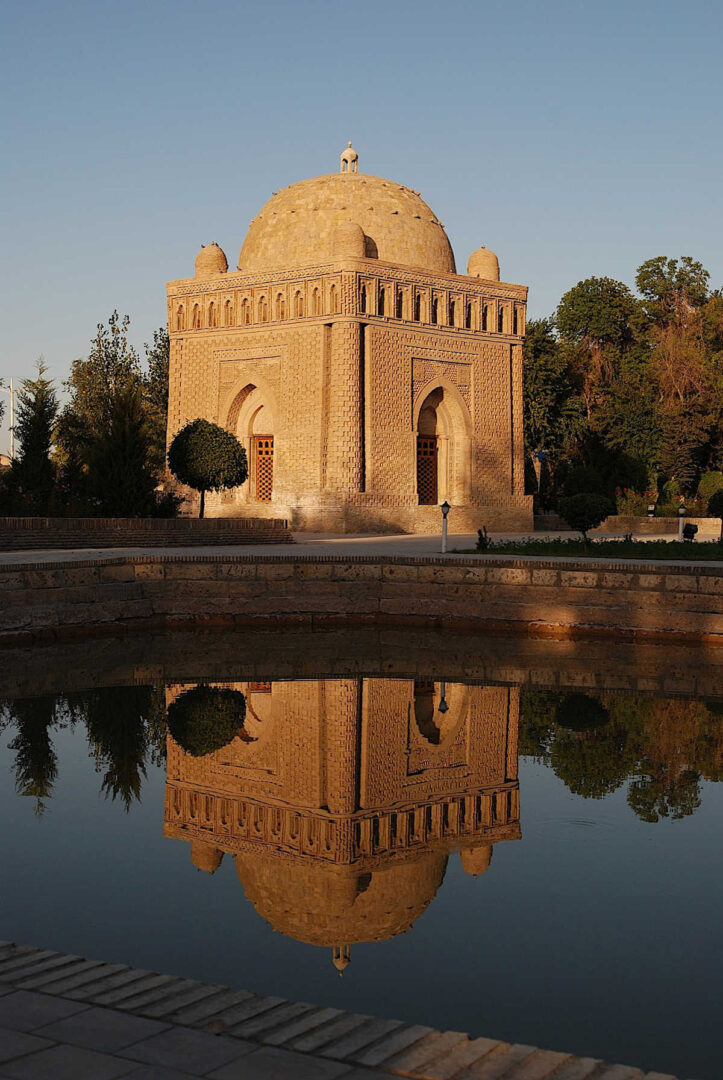Bukhara - Secret of Samanid Mausoleum
To the west of Registan Square in Bukhara, in the greenery of the park, situated on the old “Naukand” cemetery, there is a perfect architectural creation – the Samanid mausoleum and the secret connected with it. It is believed to be the tomb of the Samanid rulers, which was built in the late IX to early X century. centuries.
It is possible that the construction of the mausoleum was a response of the Samanids to the call of the Abbasid caliphate, where in 862 the mausoleum of Qubba al-Sulabiyya was built over the tomb of the Caliph of al-Muntasir.

It is important for our topic that these were probably the first Islamic mausoleums in which the original form of the right dome “Qubba dome” was embodied. The secret of Samanid mausoleum in Bukhara lies in its richest brick decoration and exquisite architectural composition, which many scholars attribute to the pre-Islamic culture of the ancient Sogdiana.
This contradiction gave rise to the idea of versions of the earlier construction of the mausoleum and even to interpret it as a Zoroastrian temple of the sun. Let us try to solve this problem on the basis of a semantic analysis of the mausoleum symbolism.
In our opinion, the mausoleum has a main symbolic composition in its arches, which represents its essential cosmogram. This characteristic square sign is symmetrically located on both sides of the entrance to both sides of the mausoleum.
Each of the signs has four inscribed squares in its structure. The inner square is inscribed with a circle. The outline of the outer squares contains 40 “pearl rings”. Within the squares there are also large and small “double-winged” signs.
Let us take care that this composition of signs is a flat projection of the volume solution of the mausoleum itself, i.e. their cosmograms are identical. This idea is suggested, besides the connection “cube-square” and “dome circle”, by the parallel between 40 “pearls” of the sign and 40 arch-shaped openings in the upper outer part of the walls.
In the Samanid mausoleum everything from bricks, floor plan and facades is built on one square and its derivatives. This underlines once again the decisive value of the square in the symbols of the mausoleum. Possibly the influence of the Kaaba image is already very strong here.
Starting from the square, the cosmogram of the mausoleum can then be broken down into three symbols based on the square:
- the already known sign “circle in square”,
- the sign “square inscribed in the square” and
- the sign “two squares with forty pearls”
1. “circle in square” is the original original form of the mausoleum, as shown above.
2. the characteristic feature of the mausoleum is its chortaku-like opening on all four sides, which explained the possibility of the source of its spiritual power.
Probably this idea is expressed by an inner square shifted in orientation, the corners of which indicate the location of the entries. The wings above the arches of the mausoleum are a traditional symbol of spirituality (think of the wings of angels).
The existence of these signs determines the overcoming of worldly vanity at the entrance to the mausoleum, the initiation into the divine. The semantics of the sign “a square inscribed in a square” can also be interpreted as a symbol of the “unity of macro- and microcosm”.
The movement from the small to the large square is magnification, which means macrocosm and infinity of the universe. The backward movement (reduction) represents the microcosm and the spiritual world.
3. “Two squares with forty pearls” refers to the symbolism of the sacred number 40. In the Islamic tradition the fate of the soul at birth and death is connected with it: Forty days the soul enters the body of a newborn child, forty days it does not leave the earth after death.
Considering the purpose of the monument, we can also assume that the “forty pearls” of the mausoleum symbolise the “forty saints” – Chiltan (Persian, Tajik – “forty people”) who protect the world.
The Uzbeks and Tajiks, Kazakhs and Kyrgyz have preserved old legends about “Chiltans” – the forty years of the “secret saints” or “innermost people”. Later, they became intertwined with the Sufi and Ismaelite beliefs and brought Chiltans into the circle of Muslim saints.
Then the square “fence” of 40 pearls on the shield means the protection of the mausoleum by 40 powerful saints, the spiritual connection of the buried saint with them. The image of the 40 light sources (arched windows) illuminating the mausoleum and thus counteracting the darkness corresponds well with the image of the 40 saints protecting the mausoleum.
Furthermore, the sacred number “forty” for Maverannahr and Khorezm was one of the characteristics of the secret association of senders of the Siyavush cult (zhretses’ corporation) in the early Middle Ages.
The image of Siyavush embodied a sun deity associated with a calendar-agrarian cult whose high priest in pre-Islamic Bukhara was the ruler of the region. Thus the cosmogram of the Samanid mausoleum combines Islamic and pre-Islamic symbols.
This is a proof of the two faiths of the population, who officially accepted the new Islamic faith but continued to practice “pagan” rituals, and of the fact that the two were officially recognised by the Samanids.
It is likely that the proclamation of Samanid statehood independently of the Abbasid caliphate in the 60-70s of the 9th century demanded local pre-Islamic religious ideas and symbols in the interest of cultural sovereignty and the sanctification of the new ruling dynasty.
This explains the “secret” of Islamic Samanid mausoleum.
